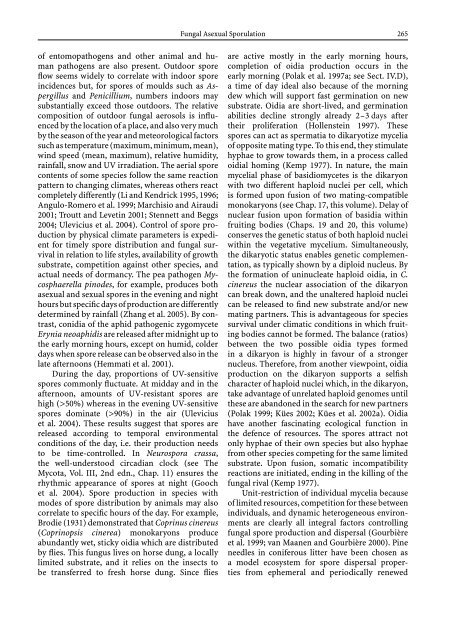Growth, Differentiation and Sexuality
Growth, Differentiation and Sexuality
Growth, Differentiation and Sexuality
You also want an ePaper? Increase the reach of your titles
YUMPU automatically turns print PDFs into web optimized ePapers that Google loves.
of entomopathogens <strong>and</strong> other animal <strong>and</strong> human<br />
pathogens are also present. Outdoor spore<br />
flow seems widely to correlate with indoor spore<br />
incidences but, for spores of moulds such as Aspergillus<br />
<strong>and</strong> Penicillium, numbers indoors may<br />
substantially exceed those outdoors. The relative<br />
composition of outdoor fungal aerosols is influencedbythelocationofaplace,<strong>and</strong>alsoverymuch<br />
by the season of the year <strong>and</strong> meteorological factors<br />
such as temperature (maximum, minimum, mean),<br />
wind speed (mean, maximum), relative humidity,<br />
rainfall, snow <strong>and</strong> UV irradiation. The aerial spore<br />
contents of some species follow the same reaction<br />
pattern to changing climates, whereas others react<br />
completely differently (Li <strong>and</strong> Kendrick 1995, 1996;<br />
Angulo-Romero et al. 1999; Marchisio <strong>and</strong> Airaudi<br />
2001; Troutt <strong>and</strong> Levetin 2001; Stennett <strong>and</strong> Beggs<br />
2004; Ulevicius et al. 2004). Control of spore production<br />
by physical climate parameters is expedient<br />
for timely spore distribution <strong>and</strong> fungal survival<br />
in relation to life styles, availability of growth<br />
substrate, competition against other species, <strong>and</strong><br />
actual needs of dormancy. The pea pathogen Mycosphaerella<br />
pinodes, for example, produces both<br />
asexual <strong>and</strong> sexual spores in the evening <strong>and</strong> night<br />
hoursbutspecificdaysofproductionaredifferently<br />
determined by rainfall (Zhang et al. 2005). By contrast,<br />
conidia of the aphid pathogenic zygomycete<br />
Erynia neoaphidis are released after midnight up to<br />
the early morning hours, except on humid, colder<br />
days when spore release can be observed also in the<br />
late afternoons (Hemmati et al. 2001).<br />
During the day, proportions of UV-sensitive<br />
spores commonly fluctuate. At midday <strong>and</strong> in the<br />
afternoon, amounts of UV-resistant spores are<br />
high (>50%) whereas in the evening UV-sensitive<br />
spores dominate (>90%) in the air (Ulevicius<br />
et al. 2004). These results suggest that spores are<br />
released according to temporal environmental<br />
conditions of the day, i.e. their production needs<br />
to be time-controlled. In Neurospora crassa,<br />
the well-understood circadian clock (see The<br />
Mycota, Vol. III, 2nd edn., Chap. 11) ensures the<br />
rhythmic appearance of spores at night (Gooch<br />
et al. 2004). Spore production in species with<br />
modes of spore distribution by animals may also<br />
correlate to specific hours of the day. For example,<br />
Brodie (1931) demonstrated that Coprinus cinereus<br />
(Coprinopsis cinerea) monokaryons produce<br />
abundantly wet, sticky oidia which are distributed<br />
by flies. This fungus lives on horse dung, a locally<br />
limited substrate, <strong>and</strong> it relies on the insects to<br />
be transferred to fresh horse dung. Since flies<br />
Fungal Asexual Sporulation 265<br />
are active mostly in the early morning hours,<br />
completion of oidia production occurs in the<br />
early morning (Polak et al. 1997a; see Sect. IV.D),<br />
a time of day ideal also because of the morning<br />
dew which will support fast germination on new<br />
substrate. Oidia are short-lived, <strong>and</strong> germination<br />
abilities decline strongly already 2–3 days after<br />
their proliferation (Hollenstein 1997). These<br />
spores can act as spermatia to dikaryotize mycelia<br />
of opposite mating type. To this end, they stimulate<br />
hyphae to grow towards them, in a process called<br />
oidial homing (Kemp 1977). In nature, the main<br />
mycelial phase of basidiomycetes is the dikaryon<br />
with two different haploid nuclei per cell, which<br />
is formed upon fusion of two mating-compatible<br />
monokaryons (see Chap. 17, this volume). Delay of<br />
nuclear fusion upon formation of basidia within<br />
fruiting bodies (Chaps. 19 <strong>and</strong> 20, this volume)<br />
conserves the genetic status of both haploid nuclei<br />
within the vegetative mycelium. Simultaneously,<br />
the dikaryotic status enables genetic complementation,<br />
as typically shown by a diploid nucleus. By<br />
the formation of uninucleate haploid oidia, in C.<br />
cinereus the nuclear association of the dikaryon<br />
can break down, <strong>and</strong> the unaltered haploid nuclei<br />
can be released to find new substrate <strong>and</strong>/or new<br />
mating partners. This is advantageous for species<br />
survival under climatic conditions in which fruiting<br />
bodies cannot be formed. The balance (ratios)<br />
between the two possible oidia types formed<br />
in a dikaryon is highly in favour of a stronger<br />
nucleus. Therefore, from another viewpoint, oidia<br />
production on the dikaryon supports a selfish<br />
character of haploid nuclei which, in the dikaryon,<br />
take advantage of unrelated haploid genomes until<br />
these are ab<strong>and</strong>oned in the search for new partners<br />
(Polak 1999; Kües 2002; Kües et al. 2002a). Oidia<br />
have another fascinating ecological function in<br />
the defence of resources. The spores attract not<br />
only hyphae of their own species but also hyphae<br />
from other species competing for the same limited<br />
substrate. Upon fusion, somatic incompatibility<br />
reactions are initiated, ending in the killing of the<br />
fungal rival (Kemp 1977).<br />
Unit-restriction of individual mycelia because<br />
of limited resources, competition for these between<br />
individuals, <strong>and</strong> dynamic heterogeneous environments<br />
are clearly all integral factors controlling<br />
fungal spore production <strong>and</strong> dispersal (Gourbière<br />
et al. 1999; van Maanen <strong>and</strong> Gourbière 2000). Pine<br />
needles in coniferous litter have been chosen as<br />
a model ecosystem for spore dispersal properties<br />
from ephemeral <strong>and</strong> periodically renewed

















